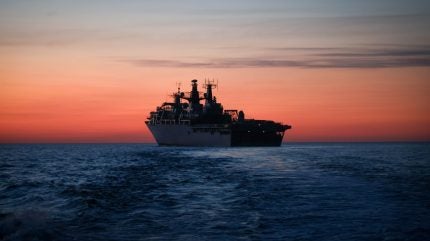
The size of the capability gap between the UK Royal Navy’s scrapping of its amphibious assault fleet and any prospective Multi-Role Strike Ship (MRSS) replacement has been revealed, with the MRSS not due to enter service until 2033 at the earliest.
Until then, the Royal Fleet Auxiliary’s three Bay-class landing ship docks will fulfill the role of amphibious support vessels, although they are mainly civilian crewed and less capable than the outgoing HMS Albion and HMS Bulwark, which were recently scrapped by the new Labour government as part of wide-ranging cuts to defence.
In a parliamentary written response on 5 December 2024, Maria Eagle, Minister for Defence Procurement, incorrectly stating the Bay-class were Royal Navy vessels, revealed that the MRSS was “in the concept phase” and “aims to deliver the first of class by 2033”.
Eagle added that the Bay-class vessels, as well as aviation support vessel RFA Argus, are planned to have left service by 2034. Introduced in the mid-2000s, the Bay class will have served more than 25 years by their now expected out-of-service date, while RFA Argus will have operated for more than 50 years by the time it departs.

Given this, it is likely that the Bay’s and RFA Argus will have to undergo a recertification process and possible mid-life upgrade, in order to sustain them in service for another decade.
It is not clear whether the MRSS vessels will operate under the Royal Navy flag or by the civilian-led RFA. Eagle’s 5 November response indicated the MRSS would “recapitalise the Royal Navy’s amphibious fleet”, and also went on to attribute the Bay class and RFA Argus as being part of the naval service.
MRSS: No commitment to like-for-like hull replacement
Announced by the previous Conservative government in May 2024, the MRSS as a class are intended to replace the two Landing Platform Docks (HMS Albion and HMS Bulwark), the three LSDs of RFA Lyme Bay, Mounts Bay and Cardigan Bay, and the Aviation Support Ship RFA Argus, in the early 2030s.
The then government provided a fig leaf commitment to retain HMS Albion and HMS Bulwark until 2033/2034, although since 2010 only a single vessel has been active with the other place in long-term regeneration that typically lasted for several years.
It was recently disclosed that both HMS Albion and HMS Bulwark were due both be kept at lower readiness, with availability to be worked up if required, through to their expected decommissioning, having not been to sea since 2023 and 2017 respectively.
However, the decision to scrap both vessels by the new government has been controversial, removing any element of Royal Navy amphibious assault capability in strategic reserve and instead leaving the role to the civilian-led Royal Fleet Auxiliary.
Initial plans called for “up to six” MRSS to be built, although there has been no commitment to numbers for some time, indicating the possibility that fewer vessels will be acquired, representing a real-terms drop in hulls in the future amphibious force, mirroring the devastating reduction in UK surface combatant numbers in recent years.







